-2025.jpg)
Holly Stevenson at The Freud Museum, London, 2025. Photo: Charlie Gray.
by ANNA McNAY
It has been a busy year for the London-based ceramic artist Holly Stevenson (b1975, King’s Lynn), and 2026 is looking to be no less active, with exhibitions, residencies and the publication of her first novel. Stevenson made time, from Thames-Side Studios in Woolwich, south-east London, to speak to Studio International via Zoom.
Anna McNay: You have just had a joint exhibition, A Hyena Wore My Face Last Night, at C+N Gallery Canepaneri in Milan, where the titles of all of the works were taken from the brilliant short story, The Debutante, written by Leonora Carrington. You also had a significant solo exhibition, Tracing the Irretraceable, at the Freud Museum in London, in collaboration with the Jane McAdam Freud Estate.
Holly Stevenson: Yes, my work is really interested in surrealism with a capital S. For a long time, the surrealists have been men, and I think it’s the zeitgeist, that at the minute we’re having a resurgence of surrealism, because we are in a time of world war, and the surrealists were famously pacifists, and as pacifists they embraced Freud, in part because they resorted to their dreams. I also think the resurgence of surrealism has really come about in a very feminist way. Our Leonora Carrington-inspired show, without us even realising, was being held concurrently with the biggest exhibition of her work at the Palazzo Reali in Milan (20 September 2025 to 11 January 2026). The dinner was amazing for our show because the next day was their press day, and so the great Alyce Mahon came, along with Giulia Ingarao, who writes extensively about Carrington, and they loved the show. It was really such a funny coincidence. But I also think the art world does move in fashions, wrongly or rightly, because it likes to shine a light on things that need to have a light shone on them. I think this current focus on the surrealist female artist, rather than the surreal female muse, is a really positive thing. Lee Miller, for example. We’ve got her exhibition at Tate Britain, where we’ve also just seen Ithell Colquhoun. Leonora Carrington is everywhere.

Holly Stevenson, Tracing The Irretraceable, The Freud Museum, 2025. Installation view of Anna Freud’s room with Eye Feel The Sun, 2024. Photo: Charlie Gray.
AMc: Yes, there was a really good show, Enchanted Alchemies: Magic, Mysticism, and the Occult in Art, at Lévy Gorvy Dayan recently, featuring a great many female surrealist artists.
HS: Yes. Obviously, there were the original surrealists with a capital S, but I think surrealism is still so present in so many people’s work. Mine included. The four pillars of surrealism – knowledge, revolution (and by revolution they really mean art), dreams and love – are pretty good themes to follow the whole way through.
AMc: They’re pretty all-encompassing, really.
HS: Definitely. That said, what makes something surreal and something not surreal? When is something surreal with a capital S? I guess when it treads the path of psychoanalysis and understanding that things aren’t straightforward? And maybe when it takes mental health into consideration? Because, thinking about it, most of the female surrealists that I’m interested in definitely had times of trouble. And I think that comes through in their work.
AMc: I read somewhere that the male surrealists made art about psychoanalysis and mental states while the female surrealists were experiencing them first hand.
HS: That’s brilliant, yes, absolutely. Especially Carrington, who was put in an asylum in Spain and wrote an account of it, Down Below, years later. It’s such a brilliant and gruesome portrait of what it means to suffer. Rereading her work through that lens is very interesting, too.
My work is openly influenced by psychoanalysis – and not just the ideas, but by the actual process of having been in long-term psychoanalysis. I think there is a difference there. The objects I’m working with are cathected in some way. They are, for me, objects of love and horror. And that’s a slightly different relationship from just having a wider worldview. My worldview is quite small. It is located in my studio and my experience of my world.

Holly Stevenson, The Witness, 2025, ceramic: glazed stoneware with Freud's favourite ashtray, the green oval dish; Museum reference number 3111. Installation view, Holly Stevenson, Tracing The Irretraceable, The Freud Museum, 2025.
AMc: Can you talk about Sigmund Freud’s Ashtray?
HS: Absolutely. I love the Freud Museum, and I was attracted to it for many reasons. I really didn’t quite know how to handle that attraction, though, apart from going through psychoanalysis. Not only did I go through Freudian psychoanalysis, I also volunteered in the house to learn about the collection. On his desk, there’s a jadeite Russian dish – an abstracted, minimal, modernist form. I fell in love with it, and I started to remake it in clay. Then I realised it made a really good plinth for me, as a vessel, and as a base for my sculptures. In fact, you’ll see that form at the base of all my figurative sculptures. I started to play with it, and then it became quite grotesque. Things just grew out of it. As I became more equipped to understand the process that I was in, and while I was in psychoanalysis, the forms became sleeker and more knowing, to the point where I was invited to work with the Jane McAdam Freud Estate. That was an exciting time, where I got to look at Jane’s work through Sigmund’s theories, and vice versa. That then moved on to where I had a show at the Freud Museum, and I got to exhibit my ashtrays alongside his favourite ashtray. The power of manifesting is quite ridiculous! But, as Freud said in Totem and Taboo, artists are the only people who have the ability to make magic. It’s that willpower of an artist, fully demonstrated in that story. That ashtray, for me, became many things. I also battled with smoking for a long time. So even basic facts became attached to the ashtray. It’s one of the few objects in the Freud house that’s unknown. No one really knows where it came from. It has a prominent place on his desk. The ashtray is Russian. My grandmother was Russian, so there was this link too. Then it looks like a green eye, and it is very female in its form, very ovoid. I fell in love with that form, maybe in the same way that Lucio Fontana fell in love with slashing canvases. How can I explain this strange behaviour? But then, when you see the fruits of the strange behaviour, it makes complete sense.
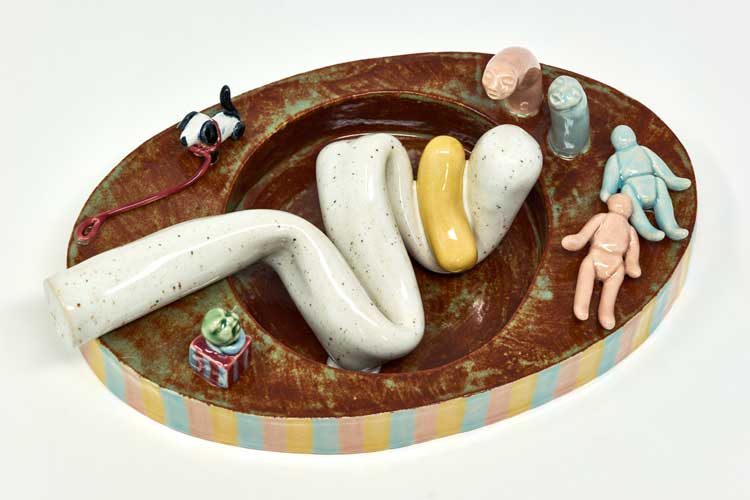
Holly Stevenson, Sibling Displacement, 2025. Ceramic: glazed stoneware: Unique work from the series Sigmund Freud’s Ashtray.
AMc: Can you say a bit more about working with the Jane McAdam Freud Archive and also the Louise Bourgeois one? What has it meant for your practice?
HS: I was born in King’s Lynn, and I didn’t really know what an art school was. When I got to university, I thought, well, do art history, because I’d been taught by somebody who inspired me. So, I went to do art history, and therefore I already had an idea of that mechanism, that way of looking at art, through archives. I became an artist, and I moved on to my master’s in fine art, and those mechanisms, that approach, changed, because it was all about being in the studio, and quite rightly so. But then I started to pair those things together and my work became, well, my work. I found female archives really, really relevant. I also noted the broken record of: “Oh, we’ve discovered another dead female artist”, “Oh, we brought so and so back from the dead.” No, they have always existed! I mean, artists love the works of other artists, they love art history. It’s an important part of making art to know what has come before you. For me, a female archive is a place that I really like working in; it stops the important work made by women from being forgotten.
Both those artists had a real ability to interpret psychoanalysis in their work. In a way, working with them, or working with their archives, should I say, was like a masterclass in thinking. It wasn’t just about the objects. It was more about the way that they successfully thought about the practice of analysis through their own practices. How that language worked, how that became form, how that affected their studio dynamics. They are very different, obviously, but it was satisfying to look at their communal language and how that worked. As we know, Louise Bourgeois made her big spiders from a web of family trauma. She’s an incredible artist. And Jane McAdam Freud had this way with wire mesh and making family portraits. I learned a lot about what clay meant to me through that analysis of their archives.
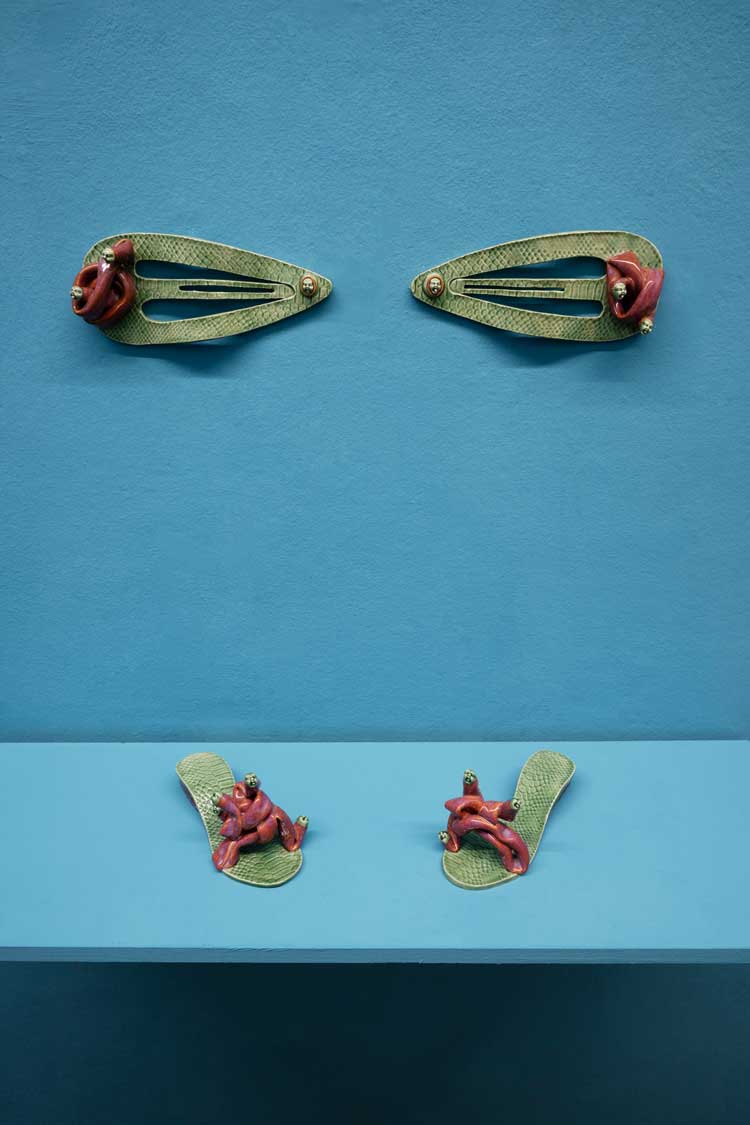
Holly Stevenson, 'My mother came in, white with fury' and 'I dont eat cakes', 2025. Exhibition image from A Hyena Wore My Face Last Night at C+N Gallery Canepaneri, Milan. Photo: Mattia Mognetti.
AMc: What attracts you to clay as a medium?
HS: It’s such a bodily material. At first, like with anything, I didn’t really realise. I knew that I didn’t want to make flat pictures. I love pictures, don’t get me wrong. I really love painters, I love painting, but there’s something about the flatness of painting that doesn’t psychologically work for me. Clay is so bodily, and it’s so fragile. Louise Bourgeois said that her mother was clay. I found that really fascinating. Then I moved on within my own practice to what clay meant to me. I did a lot of research about the mother crystal. There’s a theory that we actually come from clay, that there is a mother crystal, and that somehow this was the first and earliest form of life. So that idea of recreating a trapped idea in the body through clay became very present. In my work, I have a lot of limbs without heads and a lot of heads without limbs, but somehow it’s bodily. It’s always working to and for the body.
Clay allows a process that’s very nurturing. It goes through all these stages. First, it’s mud and wet and skin. Then it dries out, and you have to tend to it, so it doesn’t crack. You have to look after it. You almost have to feed and nurture it. Then it’s bisque fired, and it comes out white and dead and ghostly. Then you have to paint it. I see my glazing as a bit like painting. So, it’s glazed and rearticulated, and then it’s sealed and signed and sent off. It’s done. But it’s a long process.
AMc: How long a process, from start to finish, or is that impossible to say?
HS: That’s a really good question. A minimum of a month for me. I never rush pieces. I always leave them to dry really well. I revisit them. They sit under plastic. It’s almost like growing a plant. Also, clay famously has a memory, so if the clay is unhappy, if it’s been disturbed in some way, it will crack.

Holly Stevenson, I shall wear her face instead of mine this evening, 2025. Exhibition image from A Hyena Wore My Face Last Night at C+N Gallery Canepaneri, Milan. Photo: Mattia Mognetti.
AMc: Can we go back to Leonora Carrington? Can you talk a bit more about those works? What was it that made you pick The Debutante? I mean, it’s a fantastic story, but what was it that drew you to that story particularly?
HS: The curator, Joséphine-May Bailey, actually suggested that story, and at first I wasn’t very sure about it. I was thinking more along the lines of The Hearing Trumpet, because there’s so much in it, and it’s more figurative. The Debutante is a short story. I read it about three times, and then I thought: “No, this really encapsulates her.” She wrote it, apparently, in French, and when she was very young. To me, the story signals her rejection of the society that she came from, which is something that she returns to in her work over and over again. It’s definitely one of her drivers. The other driver, I think, is the fact that she believes animals are as important as humans and that somehow she could be substituted by a hyena. The more I read it, the more I found it captivating. The difference between us and animals is that we dress up, but, in this story, Carrington reverses it: it’s the animal dressing up as us. That’s very clever. And it’s that simplicity, with all those emotions poured into that reversal, that makes the story so visceral. They’re so obvious, they’re so present. I felt really inspired, so I decided to make my work, and then I went through the story again, and I titled everything with lines spoken by the characters. For example, when her mother comes to speak with her, and she’s really angry: “My mother came in, white with fury.” I had imagined what hairclips Medusa would wear, so I gave them that as a title. The Hyena has to learn to walk in heels, and I had made some tabi shoes with socks: “Turn around and see how pretty I am.” I found it really fun to make my work, but then play with her sentiment and see how that could be located within my work.
AMc: Did all the titles come after the works were made?
HS: Yes, which meant I wasn’t illustrating her work, but yet I worked with her words to, if you like, analyse my work.
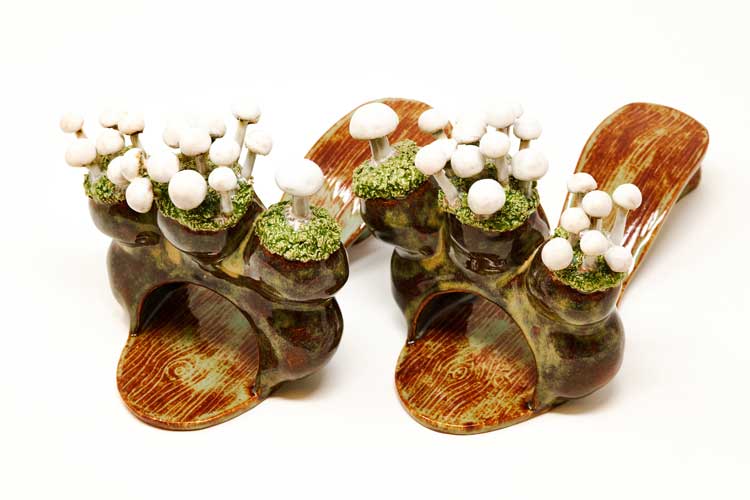
Holly Stevenson, Absolute Troopers, 2024. Ceramic: glazed stoneware. NHK Collection.
AMc: Tell me about the shoes. I know you have done a lot of research into the history of the ceramic shoe, from its origins in Persia in 2,000BC to its more surreal manifestations in the work of Meret Oppenheim and Yayoi Kusama. How has this history and fetishisation fed into your work?
HS: I’m currently talking to the Northampton Museum, where they’ve got an Arts Council-designated collection of shoes, which is incredible. They’ve got Tom Thumb’s boot, they’ve got a 1960s Christian Dior pair of bejewelled pumps – any shoe you can imagine, they have it. It’s wild. I really like the idea of ceramic shoes, and I know they’re kitschy, but there’s something about making a foot from mud. We are mud, in a sense, our feet stand on mud, we come from the earth, so this idea of making shoes from mud that walk the earth has a circularity that appeals to me … Walking – that’s the basic principle behind the shoe. Yet they have such a long history. Shoes are associated with fortune – and misfortune, too. There’s nothing more misfortunate than a pile of shoes belonging to missing people. A memorial to the children killed in Gaza was recently created in a town square in Brighton by laying out 600 pairs of children’s shoes. The shoe is such a symbolic form, and without them we are one step towards being animals again. We cover our feet, and we can, therefore, travel; we can migrate. I call my shoe series The Walking Cure, another play on the talking cure. Walking is really good for our mental health, and I love the idea of the inanimate object that becomes animate. One of my all-time favourite artworks are Marina Abramović’s crystal shoes [Shoes for Departure, 1991]. Have you ever stood in them? They’re amazing. You can’t move. They’re like rocks, and they plant you. They do the opposite of moving, but yet it’s a shoe and such a clever artwork. I really enjoy making shoes, and I’m really excited because there’s going to be a big fungi exhibition [Living Labyrinths: Art & Fungi] at Ramm [the Royal Albert Memorial Museum and Art Gallery] in Exeter, and my shoes that belong to the Huma Kabakci Collection will be a part of the exhibition.
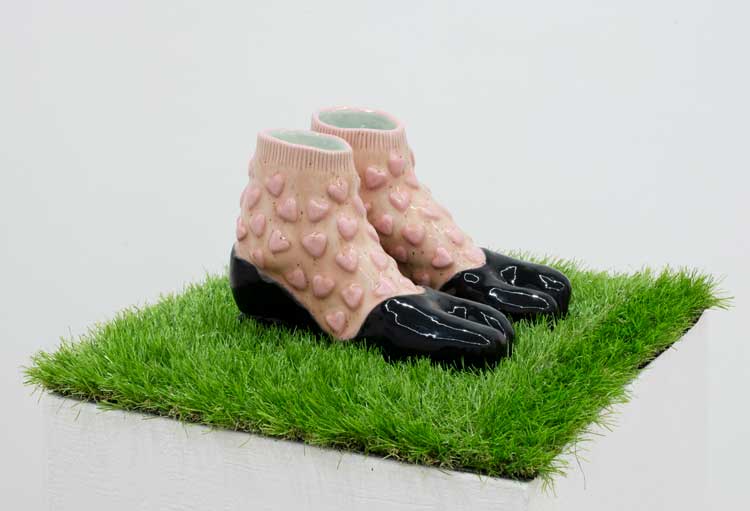
Holly Stevenson, Turn around and see how pretty I am, 2025. Exhibition image from A Hyena Wore My Face Last Night at C+N Gallery Canepaneri, Milan. Photo: Mattia Mognetti.
What more can I say? If you notice, my shoes also always have a round pebble in the heel, like a hag stone, which is a bit of a silly play on “I’ve got a stone in my shoe”, but also alludes to the protection of the evil eye. Although each pair becomes resolved, it’s an unresolved project. It’s like the ashtray. The ashtrays met their makers, so I don’t know how many more I’ll make, although I’ll carry the form with me, but the shoe I’m still resolving. I have shoes on show in Folia in Istanbul at the minute, which is a huge exhibition from the Ömer Koç Collection. I’ve seen videos of it, and it’s enormous. He collected several pairs of my shoes, including The Earth Tastes My Lips (2024), a matching plant and shoes. I like the idea that these shoes are then made from the plants, they reconnect to the ground they walk on. The leaves on this work are made from a mould of my mouth.
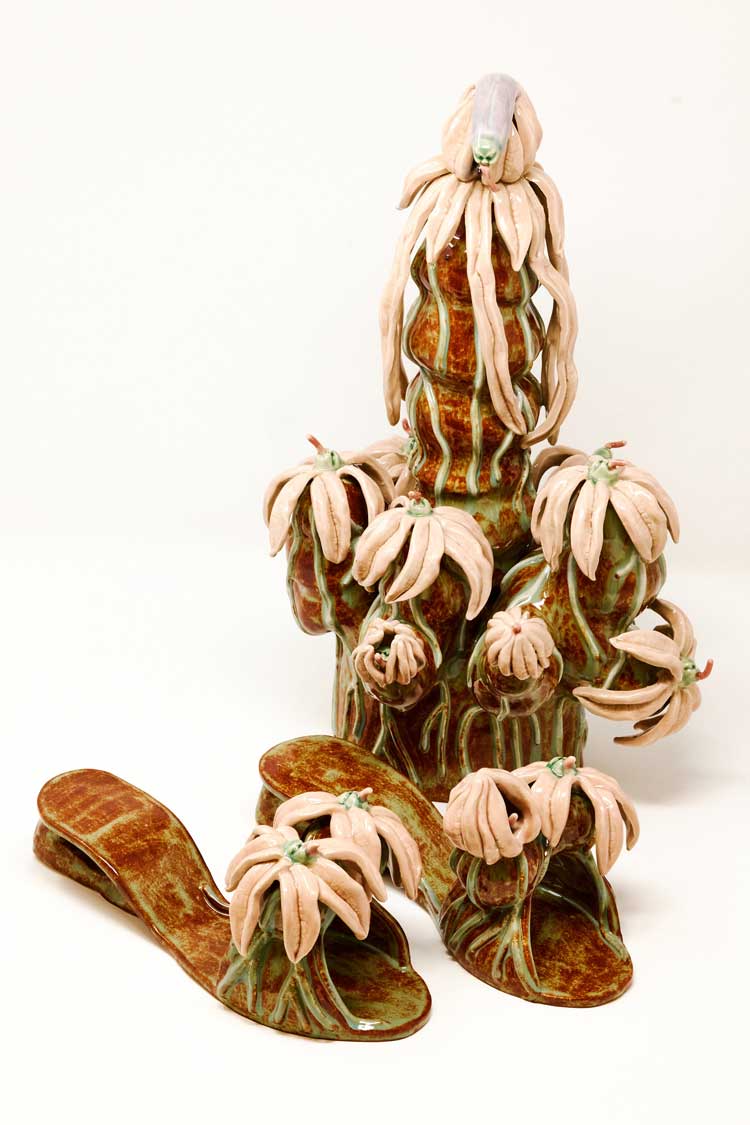
Holly Stevenson, The Earth Tastes My Lips, 2024. Ceramic: glazed stoneware. Omer Koç collection.
At the minute, I’m researching shoes and tarot figures – they’re my two big research drivers. After spending such a long time at the Jane McAdam Freud Estate – I spent two years with her – I feel a bit bereft. I love working on long-term research projects. I don’t particularly enjoy short-term things. I don’t really want to work quickly as an artist. So, yes, at the minute it’s tarot and shoes, and hopefully they’ll combine somehow. I am collaborating with an artist called Ludovica Gioscia. She and I have a research group called Ornamental Nurture, which sounds really fancy, and we’ve called ourselves a research group, but actually it’s just us. Her thing is matrescence, partly because she recently had a child through IVF, and I’m very interested in the matrixial. I think those conversations are really important, and being at Thames-Side Studios is so nice because there are so many other artists. It’s a floating island!
AMc: How long have you been there?
HS: I’ve been there coming up for five years. Before, I had an Acme studio, and I was there for 10 years. Then I moved into the Ceramics Studio Co-op and then Covid hit, so I had the whole studio to myself … a plus point in a difficult time. That’s how I learned ceramics, basically. I went to a local college. Like Grayson Perry. Exactly the same. I went to community education college, because there was another mum at the school gates who was a Royal College ceramicist, and she was like: “You should come to my class!” And so I went. And it was so cheap and so much fun.
AMc: You also have a novel being published next year. What can you reveal about that?
HS: Yes, I have. I have written a novel called Animals and Origins, which is very much the theme of our conversation, isn’t it? It’s a thriller. It’s about two people who should really, really know each other, and they even live in the same house, but they don’t know each other. The central character is a leg model, so you only ever see her legs – it’s like the view of the analyst, looking down the couch. She writes poetry to baby pandas. Although it sounds surreal, I stand by it – I’m blushing at the thought, but it’s really readable. I’m on my final edit and, weirdly, I’m going to Hogchester [in Dorset] on a residency – again, more animals – and I’m going to do my final edit while I’m there. I reckon I’ll get it published in 2026.
AMc: Well, you’ve got a pretty good track record of manifesting things, by the sound of it.
• Folia is at the Abdülmecid Efendi Mansion, Bağlarbaşı, Istanbul, to 1 March 2026; Living Labyrinths: Art and Fungi will be at the Royal Albert Memorial Museum and Art Gallery from 3 October 2026 to 21 February 2027.